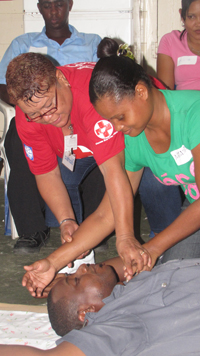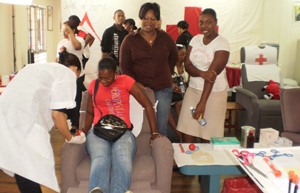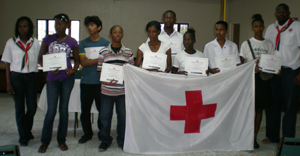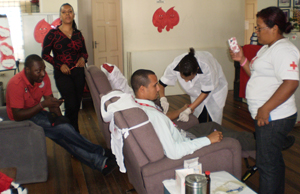
Red Cross CPR
By Jenelle Willabus
The Red Cross has over decades been carrying out humanitarian missions in excess of 150 countries worldwide and Guyana is one of those privileged countries to have been benefitting from its services
In 1948, The Guyana Red Cross Society started its operation locally as a branch of the British Red Cross. However, in 1967, a year after Guyana gained its independence, the Red Cross became a National Society by an Act of Parliament.
Currently the Society is headed by a Director General, Mrs. Dorothy Fraser. As Mrs. Fraser puts it, the Guyana Red Cross Society is essentially a humanitarian organisation auxiliary to the Government, which looks at issues in health education, social welfare, disaster preparedness, water and sanitation and blood donor recruitment. Ever since its establishment, the Guyana Red Cross has been operating from a building located at Barrack Street, Eve Leary, Kingston.
The Red Cross has been rendering services which have benefitted thousands, and two of those services which Mrs. Fraser is extremely proud of are ?Meals on Wheels? and the Red Cross Convalescent Home.
The ?Meals on Wheels? programme caters to vulnerable groups and meals are provided on a daily basis. In some instances the meals are delivered, while there are some persons who visit the society to have theirs. This project sees great assistance from members of corporate Guyana, but Mrs. Fraser stresses that contributions are always welcomed to keep the much needed programme up and running.
The Red Cross Convalescent Home has also been around for decades. It was first known as the Princess Elizabeth Home which caters to children with a variety of problems. Presently located in D?Urban Backlands, the facility has been catering to children who are brought there through the Ministry of Human Services and the Child Care and Protection Agency.
?At any given time we can cater for 35 children at the home. Initially our focus was on children who were brought to us from hinterland locations and needed medical care in the city. Then we moved to caring for children whose parents? economic situation was not one which permitted them to properly care for them. As the years went by the Home, through the efforts of its caregivers, started catering for children who are malnourished, and children who are abused,? Mrs. Fraser explained.

Red Cross blood drive.
The Home not only provides shelter for these children, but also looks into every aspect of a child?s wellbeing. Wonderful care is provided by the staff of 24 persons who work shift systems. The children are provided with the best medical care possible through the efforts of the Georgetown Public Hospital, the Davis Memorial Hospital and also from visiting medical teams from time to time, as well as other charitable organizations.
But it has not been all smooth sailing. In 1996, the Society suffered a severe setback. On Christmas Eve Day of that year, the building which housed the entity was completely gutted by fire. The tragic event cast a wet blanket on the operations. But soon after, with assistance from the Government of Guyana, the Social Impact Amelioration Programme and an abundance of well wishers, a new building was soon erected on the very plot of land where it all started.
And it was with more vigour and enthusiasm that the staff and the volunteers of the Society endeavoured to continue giving selflessly to those in need of assistance ? something that had become a part of their lives for years.
The services provided by the ?family? as they would prefer to be called, are not limited to Georgetown and the coastal areas, but many hinterland locations are also benefiting. In Region One, for example, the Society is currently running a Water and Sanitation programme, which is funded by the European Union. Through this, residents of Mabaruma and Moruca benefit from health and hygiene messages as well as safe practices. In addition, the Society has been making its contribution towards the national blood drive through a recruitment programme.
?What we do is invite donors to come in and officials from the Blood Bank do the testing and drawing of the blood. And we do this on a regular basis, since this is a very critical service needed to save lives,? Mrs. Fraser said.
She added that another area of focus is training in First Aid and Disaster Preparedness. The First Aid training targets a wide cross section of Guyanese.

Red Cross first aid
?We do general first aid with specific emphasis on CPR (Cardiopulmonary resuscitation) and we follow the American Standard which is reviewed every five years and if changes are made, we follow those changes.?
More often than not members of the Society are invited to various companies to conduct first aid training with their staff. Also volunteers from the society are asked to be on standby at major events throughout the country, including school sports, international concerts and other ventures where persons trained in first aid may be required.
Mrs. Fraser asserted that these types of services are somewhat costly to the society since they sometimes have to provide transportation for their staff to and from these events and in some instances, refreshments. There are some promotional companies, however, which stand these costs.
?Most of our volunteers are not people with a lot of money but with tremendous goodwill, who are committed to helping others,? Mrs. Fraser emphasised.
Another focal point is the Community Disaster Response Programme. This deals with disaster risk reduction. Support is given by the Canadian Red Cross, through CIDA, and these programmes are primarily conducted in Regions Three, Four, Five, Six and Nine. A key component is first aid training for community members who are part of the Disaster Response Team. Assistance is also provided by the Civil Defence Commission.
Further, many communities have benefitted from vulnerability capacity assessment. This has resulted in mitigation projects in several communities, including bridges being rehabilitated, public conveniences being fixed, and in a few instances, much needed means of communication being met.

Red Cross blood drive.
Like every other organization, the Red Cross Society has had its fair share of challenges. The floods in 2005 represented one of its stiffest tests. During that period, the Society lent its support to the relief efforts. A section of its Headquarters in Eve Leary was transformed into a shelter for families who had to flee their homes because of flood waters.
While all of their members and volunteers were needed in this situation they were forced to work without the full complement of staff since many of their own were not spared the effects of that flood. Nevertheless, it can be said that the society did a commendable job during that devastating period.
It must also be noted that while this organization is mostly about giving, there are many instances where members and volunteers are rewarded for their efforts as well. The Guyana Red Cross Society has over the years been exposing their volunteers and member to overseas training and missions. Persons who work on the Society?s Regional Intervention Team have been able to visit countries such as Panama, the Bahamas, Suriname, Barbados, St Vincent, Finland, Kenya and Haiti.
Now one may ask how this organization gets by financially. Well, the Guyana Red Cross is given a yearly subvention by Government; monies are also garnered through fund raising activities and as mentioned before, the generous support of corporate Guyana.
And while funding is somewhat of an issue, there are some services which the Society will be working to expand on in the near future, these include HIV/AIDS awareness campaigns in mining districts and psycho-social support for abused children, women and men.
The society is also looking to have rehabilitation work done on the Convalescent Home. Some has already started thanks to the support of First Lady Mrs. Deolatchmee Ramotar who made a significant contribution towards this effort last year. The society is also hoping to be able to have new drivers involved in their first aid training, since the staff feel strongly about the upsurge in road fatalities.
Efforts are also in progress to expand the ?Be Safe from Violence? programme which targets children between the ages of 5 and 9. This programme is run in some schools and churches, and then aim is to raise awareness among young children about abuse and how to ?speak up until they are heard?.
Meanwhile, the Society is appealing to members of the public who may be interested to get involved, as help is always needed when it comes to humanitarian work. With branches in Moruca, Mabaruma, Port Kaituma, Bartica, Lethem and one soon to be established in New Amsterdam, there is no such thing as too much help.
?If you have a love and a heart for helping persons in difficult situations the Red Cross Society is always looking for a new face,? Mrs. Fraser stated.
The International Federation of Red Cross and Red Crescent Societies (IFRC) is the world?s largest humanitarian organization, with 188 member National Societies. As part of the International Red Cross and Red Crescent Movement, their work is guided by seven fundamental principles; humanity, impartiality, neutrality, independence, voluntary service, unity and universality.
ferris state hockey mary poppins john derbyshire kinkade thomas kinkade paintings easter bunny navy jet crash virginia beach
No comments:
Post a Comment
Note: Only a member of this blog may post a comment.